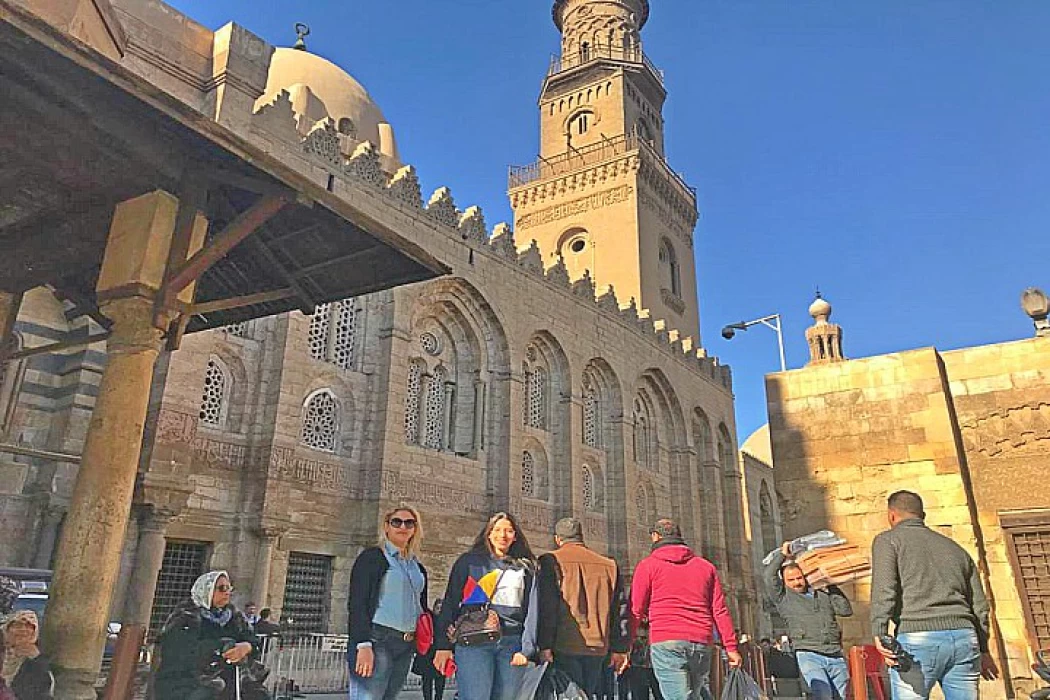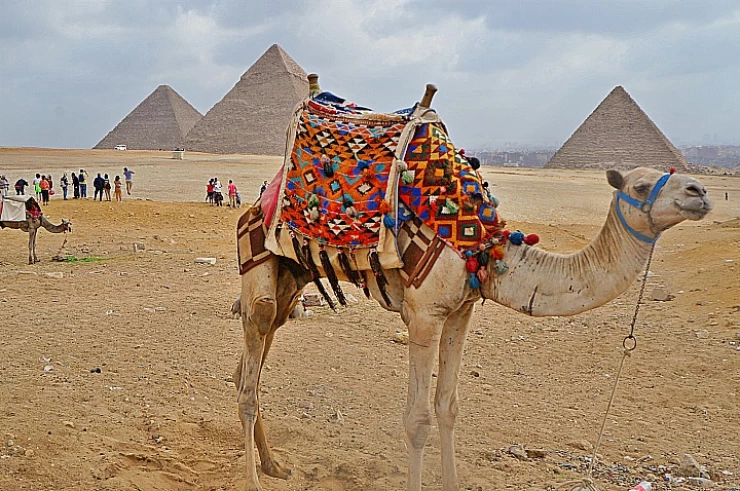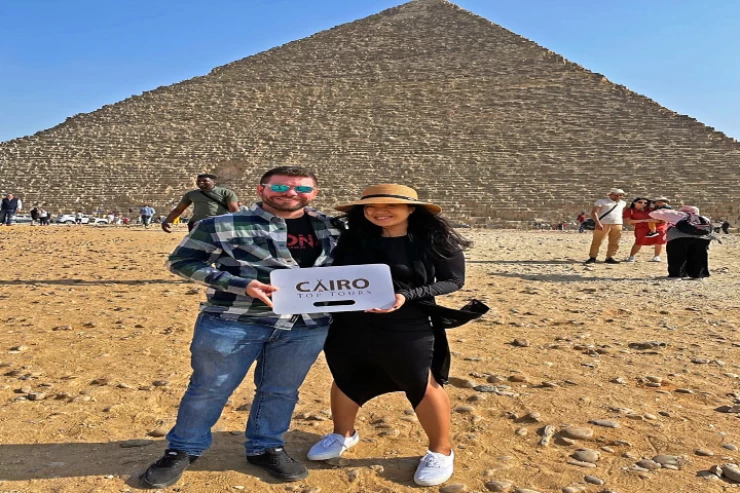
La strada del Moez
El Moez Street
È una delle più belle strade El Moez Street ed anche considerata una delle strade più antiche in Egitto. specialmente nel Cairo islamico. Dove sono stati trovati i più grandi tesori architettonici del mondo islamico. È sicuramente il più grande museo all'aperto di arte islamica del mondo.
La via del Moez ora contiene la quantità più illustre di edifici e monumenti islamici che vengono visitati di solito in Egitto durante qualsiasi viaggio al Cairo islamico. Percorrendo il cuore del Cairo islamico per tutto il suo spazio, da Bab al Futuh a Bab Zuweila, capiamo come questa strada sia considerata uno dei luoghi più vitali del Cairo islamico.

La sezione settentrionale della strada si estende dalla Moschea Di Al-Hakim Be Aamr Ellah considerata una delle più grandi moschee d'Egitto e si trova a nord del Mercato in Al-Azhar Street, passando per La moschea Al-aqmar (una delle le poche moschee fatimidi ben protette) e il complesso Qalawun.
La straa del Moez è una delle strade più storiche che puoi esplorare pazientemente durante il tour del Cairo islamico se pianifichi un tour in Egitto, quando visiti al Moez Street puoi scoprire la civiltà islamica.
La parte meridionale si estende da Al Ghuriyah a Bab Zuweila. Una passeggiata lungo questa strada, che termina con un labirinto di negozi nel classico bazar Khan Al-Khalili.
Al-Muizz Street rende semplice sentire sia la storia del Cairo islamico che il quartiere moderno che esiste oltre a questa architettura in via di sviluppo durante molti tour giornalieri del Cairo. La strada che va da (Bab Al-Futuh ad Azhar Street) dove si trova (vicino a Khan Al-Khalili) è stata recentemente restaurata.
Il nostro team vi aiuterà a viaggiare in Egitto e sperimentare il tempo soleggiato del nostro bel paese durante la Pasqua, grazie alla loro vasta conoscenza del turismo egiziano. Puoi personalizzare il tuo pacchetto selezionando uno dei nostri pacchetti di viaggio in Egitto o sfruttare al massimo il tuo tempo in una breve visita, imparando di più sulla storia egiziana e le sue affascinanti storie e vivendola attraverso tour privati al Cairo. Partecipa a uno dei nostri tour economici in Egitto attraverso il deserto del Sahara, come i tour di Siwa dal Cairo, per esempio, o preferibilmente i tour nel Deserto Bianco d'Egitto. Scoprite i nostri tour di un giorno ad Assuan, fate una gita di un giorno da Assuan ad Abu Simbel, o viaggiate via terra e godetevi i nostri tour di un giorno a Luxor per vedere gli incredibili templi di Karnak, il Tempio di Luxor, il Tempio di Hatshepsut, e vedete le meravigliose tombe splendidamente dipinte nella Valle dei Re, questo è il luogo dove i re e i governanti del nuovo regno riposano in pace e imparate i loro riti di mummificazione e sepoltura. Vi daremo un indescrivibile benvenuto in questa benedetta terra d'Egitto con l'aiuto delle nostre guide qualificate e pronte.
In Egitto esiste un luogo speciale chiamato Moschea di Abo El Dahab. È un luogo dove è possibile conoscere la cultura e la storia del Cairo islamico.
Discover the historic charm of El Moez Street in Cairo.
Located deep in the city of Cairo, one can find El Moez Street, a gorgeous time capsule of Egyptian history. El Moez Street, known to many as Al-Muizz li-Din Allah Street, is a remarkable phrase that enables one to traverse the corridors of Islamic history enriched by some of the best examples of the medieval Islamic period, perhaps many mosques, dry and wet bazaars, and a variety of other experiences. In this place, there is a harmonious combination of the historical age and the contemporary, fast-paced city of Cairo, leaving one with the feeling of having traveled to a different era.
The Historical Significance of El Moez Street
Named after Al-Muizz li-Din Allah, the street is an ode to the fourth Fatimid Caliph, who conceived the city of Cairo in the 10th century. The street, originally intended to represent the fulcrum of the new city, later developed into one of the central streets of the medieval Croatian town, filled with houses, mosques, and market halls. El Moez Street retains traces of this history, having changed over centuries as Cairo became an administrative center and later, a commercial center.
Moreover, it is still among the oldest stretches of way in Cairo, which has some historic structures that have been very well preserved. Walking along El Moez Street feels as though one is traversing an open museum of art that tells the story of Egypt’s Islamic Art period, which lasted from the 10th century to the 17th century. The street can support attestation of Cairo’s illustrious past, where it served as a melting pot for different cultures and one of the many fascinating architectural attributes of the street, making it the world’s most beautiful intracity street.
Architectural Marvels Along El Moez Street
El Moez Street is characterized by a wide range of architectural works that include buildings from various Islamic Empires, such as the Fatimid, Mamluk, and Ottoman civilizations. Each structure is unique with detailed decoration and its cultural history. Here are some of the highlights that you should not miss while walking down the street:
Al Azahar
Though slightly tucked away from the main street, Al-Azhar Mosque is just within walking distance, and it is one of the oldest and most revered centers of worship located in the Islamic World. Constructed in 970 A. Dominated by the center of Islamic culture, Al-Azhar, for quite a few ages, this mosque is remarkable for its incredible design. The minarets are elegant, and the mosque’s courtyard is vast.
Al-Hakim Mosque
Al-Hakim Mosque is dedicated to Al-Hakim bi-Amr Allah, who ruled in the East for some time. This edifice was built during the short period when the Fatimid Empire flourished and is an example of Fatimid architecture. It has giant minarets, a grand prayer place, and decorated vaults, landscapes, and corridors built in the 11th century. This mosque is still intact even after undergoing several restorations in the course of its history, which has managed to keep the historical part of Old Kam, so it is still preserved for the coming generations.
Sabil-Kuttab: an 18th-century structure within the Katkhuda complex
This remarkable building dates back to the 18th century and is a typical example of Ottoman-styled structures. A “sail” is a dome where people fetch drinking water free of charge, while a “kuttab” is a place for teaching the children the Quran. The elaborately decorated ceiling of the building, embellished in marble, tiles, and other materials, draws the attention of many people, making it a great site for taking photographs.
Qalawun Foundation
Among the most remarkable exercises of architecturally constructed space, which embraces a mosque, a madrasa, and an institution, is the Qalawun complex. The complex was built during the era of Sultan Qalawun in the 13th century. It is typical of Mamluk's architectural style. The artistic complexity of this institutional building is beyond comprehension, having stunning intricate woodwork, stone, and marble work, as well as beautiful domes.
Home of Al Suhaymi
The house has been fully restored to its glory during the Ottoman period, showcasing the life of a prosperous 17th-century merchant. The house to this – Bayt Al-Suhaymi – comes with wooden mesh windows, a beautiful inner garden, and skillfully decorated interior signs that carry the touch of the old Cairo charm.
Situated a few meters from El Moez Street is Khan El-Khalili, a marketplace that allows tourists to buy authentic Egyptian goods, such as jewelry, spice, cloth, antiques, and much more. Filled with colors, choking with scents, filled with shouting and noise—this is the market, where people come to buy and sell.
El Moez Street is not only a great number of historical edifices standing side by side, but also a lively place full of activity for the natives and visitors around the year. Throughout the year, this street experiences different cultures in the form of arts, theater, music, folklore, and other forms of entertainment.
As you stroll through the street, you’ll find musicians playing Egyptian traditional music, artists at work, and the aroma of street foods such as falafel, koshari, and desserts like basbousa and konafa fills the air. As night falls, lanterns and colored lights are turned on as they embellish the street, making it attractive turned beautiful.
The Tannoura Dance Show is among the most done activities along El Moez Street. This is a Sufi worship dance that is performed by trained dervishes in multicolor skirts to the traditional music. This is an enjoyable experience that one has to witness. This performance normally happens at Wekalet El Ghouri, which is an old caravanserai recently used as a cultural center.


















